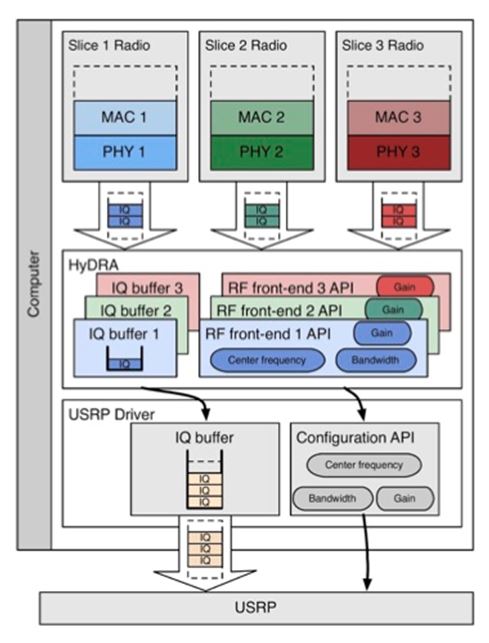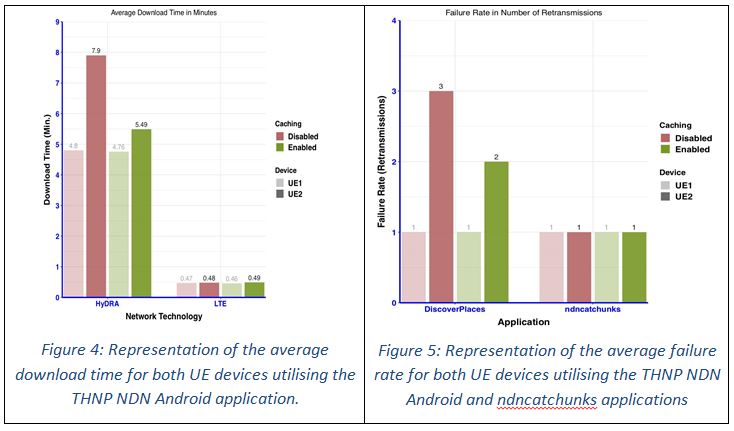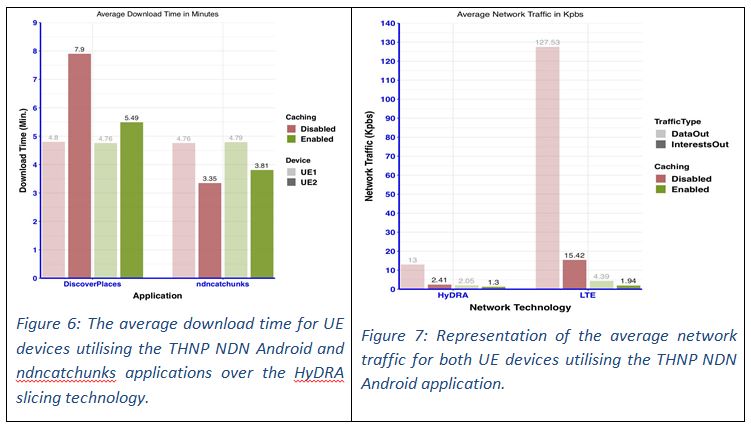Title
DynamIc REsource instantiation and ConTrol for 5G content delivery netwORks (DIRECTOR 5G)
Organization
Tara Hill National Park Teoranta (THNP)
Experiment description
The DIRECTOR 5G project was conceived to investigate and to further improve the Quality-of-Experience (QoE) of end-users in 5G wireless network environments by utilising the Named Data Networking (NDN) architecture and the HyDRA radio slicing technology. For the purpose of this project, a number of Virtual Network Functions (VNFs) have been developed to support the propagation of NDN content requests (Interests) and replies (Data) over the Orthogonal Frequency-Division Multiplexing (OFDM) radio access technology using virtualized HyDRA radio slices and the 4G Long-Term Evolution (LTE) technology. These functions are supported by the operation of an NDN Content Delivery Server (NDN-CDN) server, an NDN cache cloudlet, and a control process called D-Controller developed to support the orchestration and control of SDR parameters and radio slices within 5G wireless network environments based on end-user demand. The project was evaluated in the context of the WINS_5G testbed at Trinity College Dublin, exploiting the testbed’s software defined radio infrastructure.
Named-Data Networking (NDN) is a Future Internet architecture that has been proposed as an alternative to the conventional TCP/IP architecture[1]. NDN follows a name-based communication model that supports a number of features such as in-network caching, and packet loss and error recovery without the support of any PHY or Data Link layer error or packet corruption detection mechanisms. These capabilities were expected to reduce both the network traffic and the content-delivery delay experienced by end-users across either wired or wireless networks.
HyDRA is a Software Defined Radio (SDR) virtualization framework that supports the execution of multiple programmable air-interfaces on top of a single Radio Front-end (RF). For ease of understanding, Figure 2 illustrates the internal architecture components of HyDRA. It is a flexible tool that enables Remote Radio Head (RRH) slicing, multi-radio access networks, and multi-tenant networks. The primary objective of HyDRA is to provide a malleable and adaptable RF capable of offering different Radio Access Technologies (RAT) based on the vastly different requirements of end-users and applications in 5G environments.
In the DIRECTOR 5G architecture, NDN runs as an overlay on top of IP where available, and natively across the HyDRA sliced 5G enhanced Mobile Broadband (eMBB) Orthogonal Frequency-Division Multiplexing (OFDM) radio access technology when not.
The first objective of this experiment was to examine the benefits of the feature of in-network caching as a means to provide a better QoE to end-users. In-network caching was deployed in the DIRECTOR 5G architecture at the WINS_5G testbed, through the use of NDN cloudlets. NDN Cloudlets are small cache repositories located at the edge of the network, close to end-users. The second objective involved the orchestration and control of the Software Defined Radio (SDR) parameters and radio slices using the HyDRA framework within 5G wireless network environments. The third objective was to examine NDNs ability recover from interruptions and/or packet loss without the support of any PHY or Data Link layer error or packet corruption detection mechanisms.
Experimentation & Results
For the purpose of the experiments, the NDN VNFs developed to support the functionalities of the DIRECTOR 5G architecture including the NDN-CDN server, the NDN cloudlet, D-Controller element, and HyDRA VNFs were deployed via the 5GINFIRE portal to the 5TONIC OSM servers and instantiated at the WINS_5G production facility before beginning experimentation. Figure 3 shows the DIRECTOR 5G VNFs. Two applications, i.e. the ndncatchunks application and the THNP NDN Android application were used in the experiments to allow us to determine the performance of the DIRECTOR 5G architecture using experimental (ndncatchunks), and real-world THNP NDN Android application. Future experimenters will be able to reproduce this experiment by following the DIRECTOR 5G VNF OSM tutorial[2] using the ndncatchunks tool. The following experiments have been conducted using the evaluation metrics defined including: User based metrics – download time; and network-based metrics – failure rate, network traffic, and server load.
Figure 4 illustrates the average download time for Android Xiaomi Redmi 5 devices, i.e. devices UE1 and UE2, utilising the THNP NDN Android application. The axis x represents the network technology used, i.e. LTE, or the HyDRA network technology with OFDM, while the axis y represents the average download time experienced by a UE in minutes. According to Figure 4, the average download time has been concluded to be about 10 times lower for the LTE network technology compared to the communication over the HyDRA slicing technology using NDN. It should be noted at this point that HyDRA is an evolving experimental research framework whose initial releases do not support very large data transfer rates, since radio slices may only support 200kHz and 400kHz bandwidths respectively. Consequently, the occurrence of interruptions and the use of small bandwidth in OFDM slices is still expected to increase the overall download time experienced by the UEs compared to LTE. In contrast, LTE is a mature reliable network technology where interruptions and/or packet loss are handled using error correction mechanisms built into both the physical and the data link layer protocols.
Furthermore, according to the results concluded with regard to the failure rate metric presented in Figure 5, HyDRA has a considerable number of interruptions and/or packet loss over the HyDRA OFDM wireless slice links. However, UEs are able to overcome the interruptions and/or packet loss issues experienced on the HyDRA radio slicing framework by simply utilising the NDN architecture to automatically retransmit Interests for lost or corrupted data objects. This is the major benefit of the NDN architecture and the third objective we set out to observe during the DIRECTOR 5G experiments.
Figure 6 illustrates the average download time for both UE device experiments:1) utilising the THNP NDN Android application with Android handset, and 2)using the ndncatchunks application/tool with UE VNF connected to N210 USRPs. The figure has been generated to allow the comparison of the average download time experienced by the UEs with regard to the applications (NDN Android or ndncatchunks) and the identification of any differences between the different experiments. The results show that the average download time for the UEs when the average failure rate between the applications is equal, has been shown to remain equivalent. This is a rather interesting outcome, as it indicates that the USRP equipment used to connect the Android UEs to the HyDRA slicing technology, are able to perform the operations of modulation and demodulation of an OFDM radio signal without introducing a noticeable delay that may affect the average download time experienced by the UEs.
As shown in Figure 7, enabling caching at the NDN Cloudlet has a very large impact on the network traffic travelling on the backhaul network between the HyDRA Gateway RF node, and the NDN-CDN server. This observation supports our first objective whose goal was to determine if the network load and the load experienced by the NDN-CDN serving the primary content requests could be reduced by enabling NDN Caching.
Finally, the validation of the D-Controller element is a little harder to illustrate in a report. However, by interacting with HyDRA-As-a-Service SDR slicing technology to get available slice information, and monitoring NDN interests received by the NDN-CDN server, the THNP D-Controller element is able perform reconfigurable on-the-fly central frequency, and bandwidth decisions in the 5G wireless domain supporting our second objective.
Conclusions and Discussions
Based on the conclusions derived from experimentation performed, all three objectives as stated within the context of this project have been met.
First, according to the results, NDN cloudlets have indeed been shown to be able to reduce the amount of network traffic at the backhaul of the network infrastructure by caching content closer to the end-users. In addition to this, NDN cloudlets are also able to reduce the content delivery times experienced by end-users when a number of interruptions at the backhaul of the network infrastructure occurs. However, the benefit of utilising NDN cloudlets has been shown to be negligible when the link between the end-users and the NDN cloudlet is much slower than the link between the NDN cloudlet and the NDN-CDN server (12.7 Mbits/sec (LTE) and 16.8 Gbits/sec (WINS_5G physical network)). Second, determining the number of active tourist users by exploiting HyDRA’s management capabilities, D-Controller is able to perform reconfigurable “on-the-fly” allocation of the frequency and bandwidth parameters within 5G wireless domains. Third, applications that utilise the NDN communication model are able to overcome any interruptions and/or packet loss occurring over the OFDM radio access technology without a PHY or Link layer protocols to support packet loss and recovery or error correction. This is achieved by simply retransmitting content requests (i.e., NDN Interests) for the lost and/or corrupted data.
The conclusions derived during the life of the project will allow THNP to establish guidelines for the future development of the application as well as additional solutions using the NDN architecture. Furthermore, there is quite a significant amount of future work that can be carried out based on these initial experiments, including: (1) Increase HyDRA slice bandwidth to 1MHz+ and use different OFDM digital modulation processes to transmit and receive NDN video content, (2) Extend the D-Controller element to support reliable link and application QoS in mobile HyDRA slices, (3) Optimise the NDN content delivery across HyDRA slices and compare against LTE.






